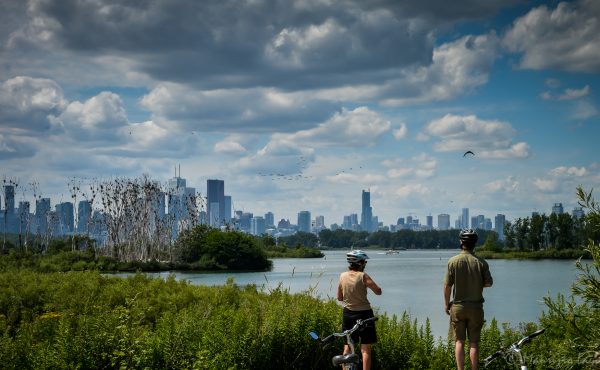
We’re launching Spacing’s “green” issue in a week, on Monday Dec. 3. To give our readers a taste of the kind of questions discussed in our new issue, we are providing an appetizer, a web-only article by Rebecca Keenan on the potential impact of pedestrian zones on Toronto’s air quality.
– – – – – – – – – – – – – – – – – – – – – – – –
Once a month, from May through September, people flood the streets of Kensington Market during Pedestrian Sundays. All this merry-making is done in the spirit of community over commuting, an ongoing testament to how much closing down roads to cars opens up neighbourhoods to people. On July 4, 2004, York University’s Centre for Atmospheric Chemistry, led by post-doctoral fellow Jean-Francois Gouin, set out to measure how much this car-free zone affects air quality. Gouin took measurements of both particulate matter (PM) and carbon monoxide (CO) on regular trafficked weekends, and then on the July 4 Pedestrian Sunday.
Particulate matter has been linked to respiratory ailments, lung cancer, and cardiovascular disease, while carbon monoxide is an asphyxiant and environmental hazard. Both are byproducts of vehicles burning fossil fuel. The study found that levels of PM did not decrease significantly, possibly due to their days-long atmospheric lifetime, the proximity of other high-traffic areas (College Street and Spadina Avenue), and the ease with which wind can carry such fine matter. The results suggested a more significant change in CO levels, however. The study found that a definitive spike in CO was registered whenever a vehicle passed within about two metres of the sampling point. Calculating an average hourly dose of CO exposure based on these spikes, the study estimated that levels on normal traffic days were at least double that of the Pedestrian Sunday.
Gouin’s supervisor, Geoffrey Harris, the director of the Centre for Atmospheric Chemistry, explains that the results were not especially illuminating from a strictly scientific standpoint. But he points out, “We didn’t go out there as an exhaustive study. It was more a sort of community outreach, to draw people’s attention to the idea that you’re in a lower pollution region when you haven’t got cars.†He refers to the study as “…more symbolic than significant.†Yet the symbolism is important. One of the problems was that the car-free zone was simply too small to impact the base level of CO present between the spikes caused by passing vehicles, let alone the air quality in the city as a whole. A much larger car-free zone would be needed, but just how much larger? Harris admits, “To be honest, I’m not sure that it has been investigated.â€
Toronto Coalition for Active Transportation (TCAT) member Jennifer Niece agrees that there is a need for roads dedicated to pedestrians, cyclists, and any other active form of transportation. TCAT is currently campaigning for clean-air corridors into the city that are closed to traffic on smog days when poor air quality is especially harmful to active travellers. Those CO spikes that Gouin discovered two metres from a passing car are a constant for cyclists and pedestrians on roads with heavy traffic. As for more permanent clean air corridors, Niece suggested that the construction of a dedicated bus corridor from Downsview subway station to York University should incorporate bike lanes, and that there are many possible routes along hydro right-of-ways. The potential to make a difference in our air quality is real and, as Niece says, failure to act now would be a serious “lost opportunity.â€
by Rebecca Keenan
photo by Gayla Trail
Check out the details of the Kensington Market air quality study
– – – – – – – – – – – – – – – – – – – – – – – –
Explore these issues further in our new issue with Andrew Robb’s article on air quality, “We need to be air-heads,” and Jay Somerset’s article on pedestrian zones, “Taking it to the Streets.”



